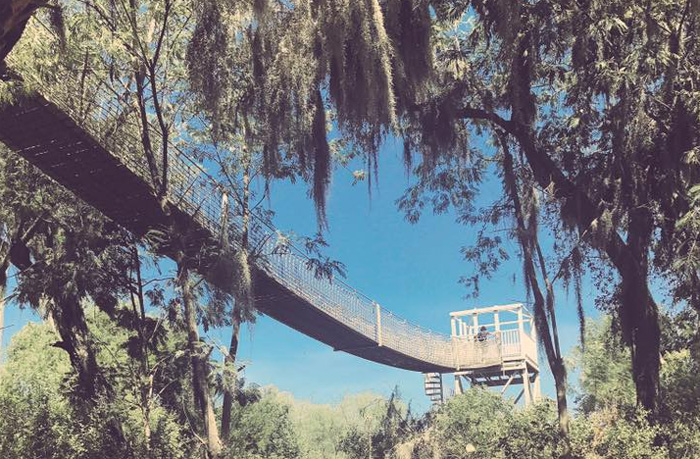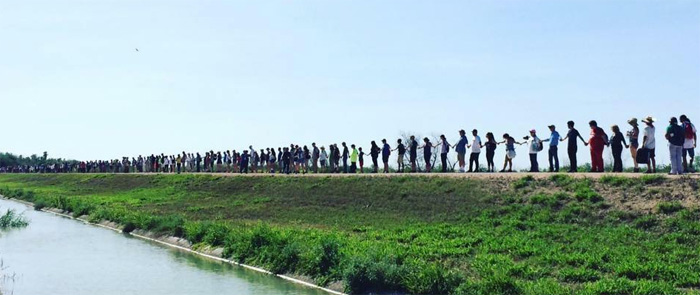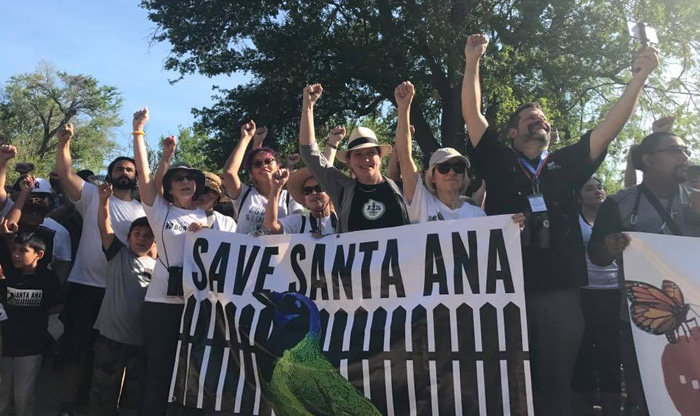One of my first undertakings as Sierra Club president reminded me that our organization’s mission to protect wild places requires inclusiveness, solidarity, and a community-based grassroots approach. (That's me in the straw hat, above.)
Breaking News: A deal reached today in the Senate will keep the government open for only three weeks, while failing to protect 800,000 Dreamers from deportation and provide aid to the states, territories and communities devastated by storms and disaster over the past six months. Congress must secure a deal to protect immigrant youth, and not use a billion-dollar boondoggle of a border wall as a bargaining chip for their futures or to keep our government up and running. Read more.
###
In stifling heat last August, I spent two days in Mission, Texas, in the Rio Grande Valley that both divides the United States from Mexico and unites the region culturally. Hugging the border north of the river is the Santa Ana National Wildlife Refuge, and on either side of the border is a community of people whose cultural commonalities are largely defined by the natural richness and biodiversity of the refuge and the Rio Grande Valley.
The offensive and senseless border wall proposed by President Trump would run smack through the heart of the Santa Ana Refuge and divide the communities of the Rio Grande Valley. I had traveled to Mission with other Sierra Club leaders and our allies to support local residents in a Weekend of Border Wall Resistance, culminating in a Stop the Border Wall rally and a tour of the Refuge, one of the best birding spots in the country and a haven for the critically endangered ocelot.
“So much of the Rio Grande Valley’s wilderness has been lost,” Sierra Club Borderlands Team activist Scott Nicol told the Texas Observer last year. “If we lose these last little fragments like Santa Ana, that’s it. It’s gone.”
It’s hard to overstate the influence a place like the Santa Ana Refuge has on people who live in the area. During my weekend in Mission, I spoke with dozens of people who have lived in the Rio Grande Valley their entire life, and every one of them was fiercely proud of the area and carried with them a deep knowledge and respect for the land. The people and the natural environment are inextricably interconnected.
That’s why the Sierra Club, with the help of groups like Rachel’s Network, is pulling out all the stops -- through legal, organizing, and lobbying efforts -- to prevent construction of a border wall that would cut the community on the U.S. side of the line off from its river, block wildlife migration routes, and deliver a body blow to the region’s rich transborder culture. The importance of the Santa Ana Refuge to the natural and cultural vitality of the region cannot be overstated. It is central to the area’s identity. Overwhelmingly, residents of Mission and other Rio Grande Valley communities north of the river don’t want a border wall.
The events of the weekend helped dismantle stereotypes, dispel the false notion that the American borderlands are a dangerous and lawless region -- in fact, the communities north of the river are some of the safest in the U.S. -- and shine a light on the rich shared culture in the Rio Grande Valley. The centerpiece of the gathering was a 2-mile march from Our Lady of Guadalupe church to La Lomita Chapel, culminating in a rally at the chapel, where local residents -- joined by indigenous leaders, immigrants’ rights advocates, and environmentalists -- emphasized through personal stories the value and the importance of keeping their home intact.
The community celebration was followed by a tour of the refuge, where local guides led us under a green canopy of Anucua and ebony trees to some of the best birding sites in the border region. The refuge is a crucial stop for migratory birds, and I was awestruck by the sight of thousands of birds, sporting every conceivable color of plumage and originating from all parts of the Western Hemisphere, soaring over the Rio Grande. It struck me as an apt metaphor for the rich transborder culture and natural biodiversity of the Rio Grande Valley. Amid all the political grandstanding and inflammatory rhetoric about the border region emanating from the White House, the commonalities shared by people on either side of the river are what stood out for me.

Photo: Courtney Bourgoin
On the second day of my visit, news arrived of the white nationalist rally and ensuing violence in Charlottesville, presenting a bleak and stark contrast with what I was experiencing in the border region. This weekend of solidarity shared by Rio Grande Valley natives, green groups, civil rights organizations, students, and many others, emphasized above all the ties that bring people together on either side of the U.S.-Mexico border. And one of the most vital touchstones shared by borderland communities in the Rio Grande Valley is the Santa Ana National Wildlife Refuge.
Over the course of many years as a volunteer leader with the Sierra Club, I’ve learned that when a community’s very survival is threatened, that community will organize and fight back. The Trump administration would do well to take heed of the broad movement to oppose the border wall. On that August weekend when I visited the area, hundreds of people joined hands to form a human chain along the route of the proposed border wall, which would run right through the heart of the Santa Ana National Wildlife Refuge. And in the months that have elapsed since then, the coalition has continued to grow and gain momentum.

Photo: Krista Schlyer
There’s a lot of talk in Washington about “protecting the border.” But protection can't be bought by spending billions to militarize the border region, imperiling its natural biodiversity and waiving environmental laws in the process. Nor can it be achieved by deporting undocumented residents who live and work north of the border. Real security comes from the communities of people who live in the borderlands, on both sides of the river -- a river that unites border communities far more than it divides them. We must continue fighting for real protection of border communities and the biodiversity of the border region.
Now, with a looming federal government shutdown, fights over the budget, and a president determined to deliver on one of his most dreadful and illogical campaign promises -- the construction of a border wall -- the threat in the Rio Grande Valley and the Santa Ana National Wildlife Refuge is greater than ever. That is why the Sierra Club will once again stand in solidarity with allies and residents of the border region to take a stand against this destructive, misguided boondoggle.
Join us in Mission, Texas, on Saturday, January 27, for a Stop the Border Wall rally, followed by activities including bird walks, a tram tour, archery, and kayaking in the Refuge. And even if you can’t make it to Texas, you can support the Rio Grande Valley community by sharing this #SaveSantaAna video on social media. For more information about the event and what you can do to help protect the Refuge and make sure the border wall never gets built, click here.
Call Congress
202-224-3121
Tell them
#NoBorderWall
#SaveSantaAna
